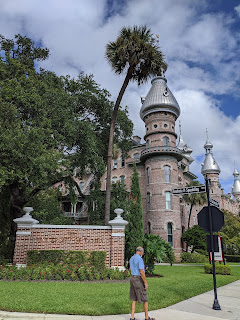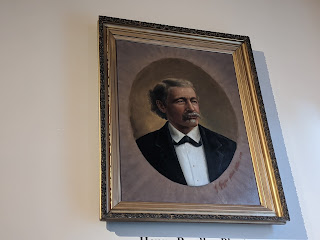After spending a thoroughly enjoyable few hours in Ybor City, now a suburb of Tampa, Steven and I drove a short distance to Tampa, one of the country's busiest ports with petroleum, coal, steel, and cement among its major inbound cargoes. Tampa has also become an important cruise terminal with passengers bound for the Caribbean and Latin American destinations. We stopped initially at Oxford Exchange, a European-inspired space with a restaurant, bookstore, and coffee house that reminded us of the Tattered Cover Bookstore here in Denver and long regarded as one of the nation's best bookstores.
This Daily Travelogue is a labor of love for our families and friends at home and around the world. Prior to 2020, all our trips were documented on separate, yearly blogs which can be accessed below. Remember that clicking on any picture will open it for better viewing. Also, please consider adding your name at the end of any comments. Be safe, stay healthy, and stay connected.
Thursday, April 8, 2021
9/12: Tampa's Plant Museum & Corduroy Roads!
Another indication about how apart we should be from one another during the pandemic was this quote from Bob Dylan who wrote "I think of a hero as someone who understands the degree of responsibility that comes with his freedom." Underneath was the none-too-subtle message: "Thank you for keeping a responsible distance."
It was easy to see how the Moorish-designed hotel with its exotic minarets, domes, and cupolas had been a magnet for the Victorian era's well-heeled denizens.
The elegant Writing and Reading Room was the most historic space in the entire building and a popular gathering spot for gentlemen of the era. Here they would read newspapers and deal with correspondence. The furniture and art were original and in the same place as when the hotel opened in 1891. I could just envision men gathering here and the room permeated with the fragrance of cigar smoke after Vicente Martinez Ybor had moved his cigar factories from Key West to nearby Ybor City after Plant built the railroad to Tampa in 1884.
Some parlor games, like lawn bowling, tennis, or croquet were miniature versions of popular outdoor sports that could be played on a tabletop. During the early 19th century, parlor games were considered more apropos for women than outdoor sports. I hadn't known before that table shuffleboard had dated to the 1400s in England while ping pong or table tennis was only invented in 1900.
The audio guide indicated there were original 19th-century Edison carbon filament lightbulbs in the hallway's light fixtures. I wonder how much longer their supply will last!
Plant, nicknamed The King of Florida, ran an international transportation company that stretched more than 5,000 miles and negotiated with heads of state and powerful captains of industry.
A new term for me was "corduroy road" which meant tree logs laid down side by side to create a hard surface because Florida sand was so soft and deep that this type of road was the only way for carts and horses to travel in the region before the advent of paved roads. I shudder thinking how uncomfortable it must have been traveling that way! As you can imagine, very few people wanted to come to Tampa as it meant traversing on corduroy roads. That changed in 1884 when Henry Plant brought the railroad to the former fishing village of Tampa. That also enabled local agricultural products to be sold in other parts of the state and even the country.
The room was designed to allow light in through the keyhole window.
Much of the hotel's social life revolved around the Dining Room and its outstanding cuisine. Guests dined formally each evening, often accompanied by an orchestra playing from the balcony. The Dining Room seated 800 of one's closest friends admiring the costly tapestries and Japanese screens while their repasts were served on Limoges china!
Before you ask for a 'doggie bag' for your leftovers the next time you leave a restaurant, think of this 1890 etiquette rule!
Guests from a bygone era were pictured relaxing on the sprawling veranda.
Visitors to the museum were limited to the first floor as the upper floors were used by The University of Tampa (UT) for classrooms, administration, and professors' offices. The furnishings from the upper guest floors, each of which had a fireplace, and access to a bathroom with hot and cold running water.
Plant and his wife traveled extensively throughout Europe while their hotel was under construction so they could purchase furniture and art for "Plant's Place." Each item was selected with the elite in mind they hoped to attract to the hotel. The Gilded Age that spanned from 1890 to 1920 owed its inspiration to the past's great civilizations and the Plants' colorful and figural sculptures were examples of their eclectic taste.
It sounded like the Plants and/or their staff must have been marketing geniuses as captivating legends became attached to some of the hotel's furnishings! Guests liked to dream the collectors' cabinet was the last one seen by Mary Queen of Scots before her beheading for treason or that a huge majolica vase was the life's work of a blind Japanese craftsman. These and other myths added to the hotel's mystique and exotic reputation.
It would have been so fun to sit a spell on this tete-a tete chair!
In addition to Teddy Roosevelt, some of the hotel's more prominent guests included Babe Ruth, composer John Philip Sousa, actress Sarah Bernhardt, and author Stephen Crane.
Theodore Roosevelt who served as the 26th President from 1901-1909 was a frequent guest at the Plants' hotel.
The veranda was sadly empty when we visited last September, likely because of the fierce rainstorm that swept through the area.
Steven and I have always liked to wander through some of the world's grandest hotels when we travel and found it a lark and undeniable treat doing the same at the former Tampa Bay Hotel!
Strolling a few steps along the veranda brought us to the university lobby that looked more like a French chateau than a gathering place for rambunctious students!
The university's early library was shown in 1934 when it was located in the former dining room, now Fletcher Lounge.
I have no doubt my mind would have wandered had I been studying under this stunning dome back in the 1930s!
It was easy to admire the exquisite scroll details on what was now a professor's office door.
The Grand Parlor had not one but two very elaborate fireplace mantels. How incredibly lucky were the UT students attending school in such opulent and historic surroundings day in and day out.
A final glimpse of The University of Tampa from the fountain across the street:
Next post: Tampa's Weedon Island Preserve and the Dali Museum.
Posted on April 8th, 2021, from a warm day in Denver. I know we can't get too complacent when it comes to springtime weather as it's due to snow, yet again, here tomorrow even though most people were clad in shorts and t-shirts today! Wherever you are, I hope you and your loved ones are toasty and warm and above all safe from the virus which is again ramping up to dangerously high levels in far too many places.
Labels:
Florida
Subscribe to:
Post Comments (Atom)

















































No comments:
Post a Comment